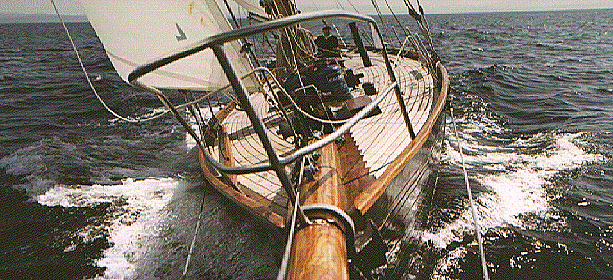
In sailing the waters of The Hebrides, todays yachtsmen follow a great tradition. In times gone by, a select number of wealthy people, with large fortunes and yachts to suit, sailed these waters, taking with them their guests.

Today, most yachtsmen are of more modest means, but the pleasures are just as great.
In the past, most of the cruises were conducted in steam yachts, so palatial that they were like ocean liners. In 1890, Sir Donald Currie launched his 'RMS Dunottar Castle'. She could accommodate 360 guests and 150 crew! A guest at the time noted:
'She has electric lighting, it's bright and cleanly and is always available. There are marble baths and a library of nearly 500 volumes. There is a barber's shop, with a rotary hair brushing machine, worked by an electric motor. The evening hours in the saloon, instead of being dreary, are looked after with pleasure.'
This vessel displaces 3,069 tons but she still cruised the Hebrides with Sir Donald's guests. When the depth of water in the sea lochs was to shallow, Sir Donald's smaller yacht 'Iolanthe' was ready and waiting alongside, to ferry the guests ashore.
The Bulloughs of Rhum owned a yacht, the 'Rouma', so large that the South African government were more than happy to borrow it as a hospital ship during the Boer War.
The Laird of Raasay owned one of the most splendid private yachts ever built. She was called 'Rona', displaced over 1,000 tons and was nearly the length of four cricket pitches. She carried on her deck, two racing-class sailing yachts.
In the mid 1800's, Thomas Brassey had built the beautiful 'Sunbeam', a sail and steam schooner. At the time, the opulence of this yacht was unsurpassed. A guest aboard wrote:
'The Sunbeam is quite a floating palace fitted up in the most luxurious manner. Her many saloons and sleeping cabins are marvels of elegance and comfort, while the taste of Lady Brassey is displayed in the numberless pictures and curios which adorn the walls and tables in the different apartments. The crew number twenty six and the yacht carries six boats'.
It was the custom for this fleet of glittering yachts to assemble in Hebridean waters every August, and then proceed in convoy, from one sheltered anchorage to the next. The paradox of all this glittering ostentation sailing among the islands was; the local population lay entrapped by the lairds, in many cases the same lairds who owned the yachts, in permanent misery and penury isolation.
In August 1847, Queen Victoria cruised in Hebridean waters. On the morning of the 12th August, the royal yacht, 'Victoria and Albert' left Crinan and set out on a cruise along almost the same route which Lazy Beaver and I will be taking in this narrative. Queen Victoria however, never ventured into Hebridean waters again, and when in the 1850's, the crofters rose against the lairds, she had no sympathy for them at all.
However, all this pleasure could not last for ever. At the outbreak of the first world war, the Highland mansions and shooting lodges were shuttered, their owners returned to their Lowland and English estates, and their glittering yachts were sailed south, to become fleet auxiliaries - What then of the crofters - they went to die at Mons and Neuve Chapelle.
The following narrative is the cruise of the yacht Lazy Beaver, not a glittering master piece of the naval architect, but an 8.7 meter GRP sloop, draught 1.4 meters, displacing 7.3 tons.